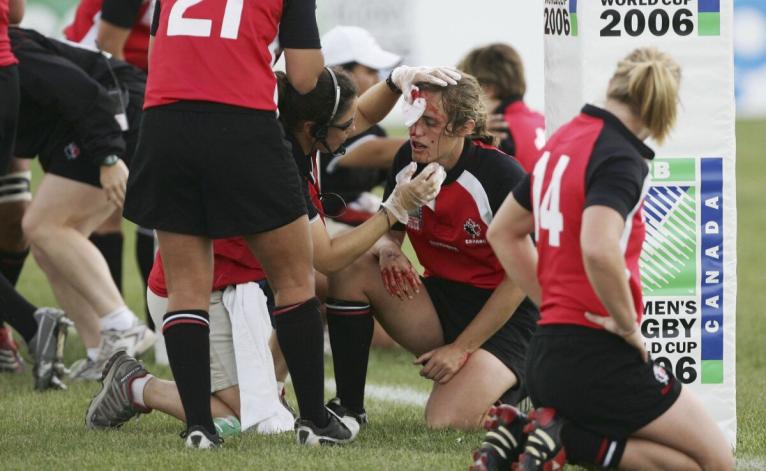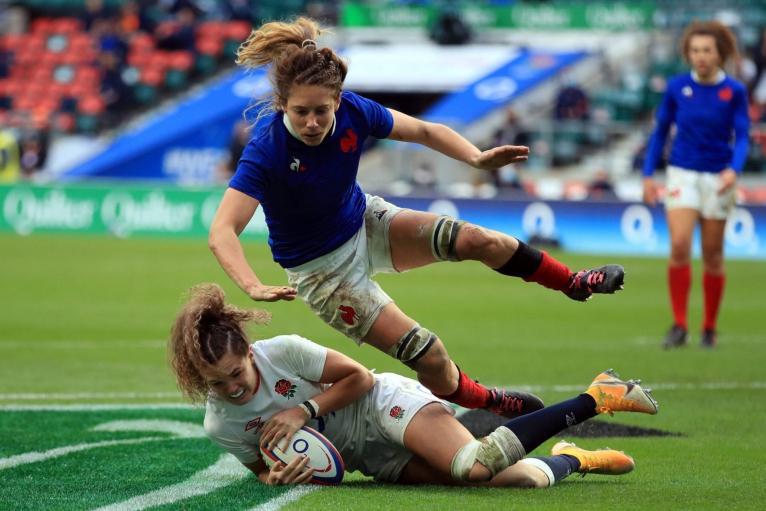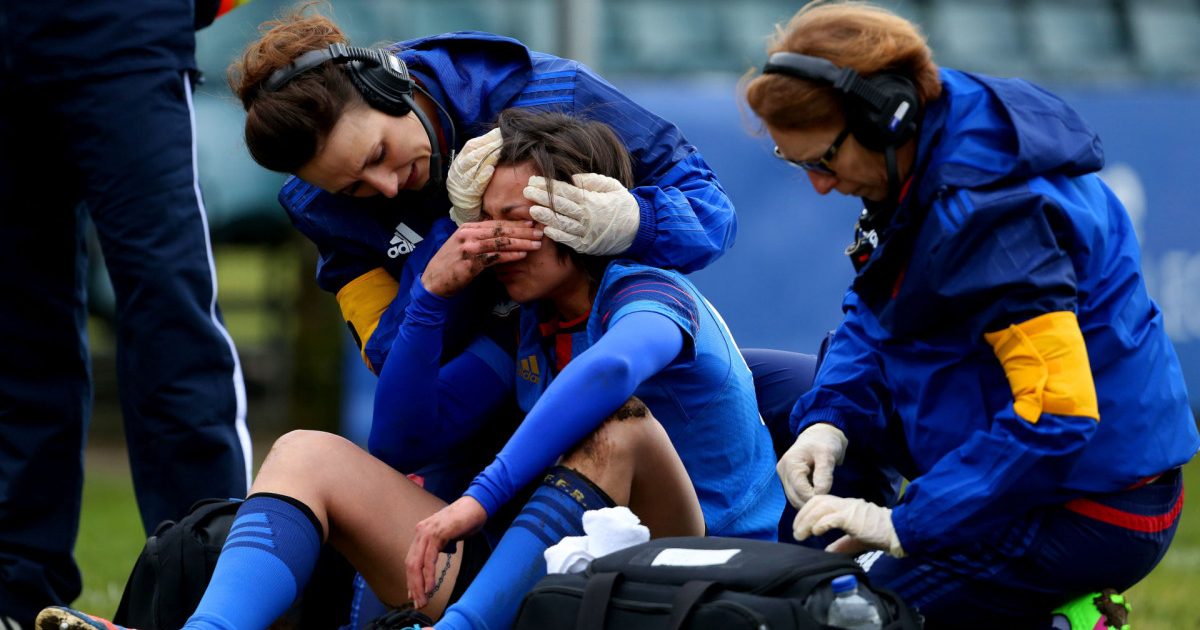Long-term brain damage likely a significantly bigger issue in women's rugby than men's, says lead concussion doctor

Last week, rugby union was shaken by the news that eight male players have been diagnosed with early signs of dementia and probable Chronic Traumatic Encephalopathy (CTE).
And, according to a lead researcher on concussion in men and women’s rugby, the story for women’s rugby players is likely to be even bleaker.
I spoke to Dr Elisabeth Williams, senior lecturer in forensic biomechanics and research scientist at Swansea University, who is a lead researcher into concussion in both men’s and women’s rugby. Last year, Dr Williams started tracking head injuries in rugby union through putting sensors in the gumshields of Swansea University men’s and women’s first teams.
The research was the first of its kind: it found that the impacts in women’s rugby were far beyond what had previously been thought. “With tackling, what we haven’t seen is those hard impacts that you see in the men’s game,” Dr Williams says, “what we are seeing is harder whiplash motion hits, with head to knee and head to ground impacts.
“The first time I actually saw how hard [the impacts the women received] were, it was somebody going head to knee, head to ground, with no control of their head at all; no conscious awareness of her body in space. That’s when my blood went cold. I thought the sensors must be wrong. That was when I went back, and I looked at all the data and I recalibrated all the sensors. I did all of the steps that you would do if you’re not sure that your equipment is reading right. And it was reading fine. And we saw those [high impact readings] throughout the season.”
Dr Williams’ latest work now explains the reason behind the whiplash motions we see in women’s rugby: women’s neck strength is so unfathomably low compared to men, that many women have absolutely no control over their heads when going into contact.
“Even just watching the Black Ferns play England, you can see that even the best women in the world have that tendency for that whiplash motion,” Dr Williams explains, “a lot less than the university women, a lot less, but they still throw their heads. The Black Ferns are awesome, but I don’t know if their neck strength would be on par with our university men.”
At the elite level, the lower body strength between men and women is closer, with men squatting around 100kg more than women, but men’s upper body strength is “triple or quadruple” the strength of women’s, Dr Williams explains. “When you get to your neck, there’s so few studies on it that it’s hard to generalise. When we look at all of the results we have got… the women’s neck strength has been considerably lower than the men across sports and across all levels of the game as well.”
There were a couple of outliers in the research, women’s rugby players whose scores are on par with the lowest of the men’s, but it’s a rare occurrence. That gives Dr Williams hope, she says, because it tells us that neck strength is trainable. “It’s not that we’re stuck in this ‘women have weaker necks therefore we’re always going to see these massive head-to-ground impacts’”, she explains, “it is trainable. That’s really awesome, it’s just getting buy-in from the women who don’t want to look like The Hulk.”
The England women’s team have been using neck training since 2014, one senior player tells me, to improve the stability of their necks. Some clubs in the Allianz Premier 15s have adopted neck training too, using exercise bands to improve the strength of their necks and hopefully prevent concussion. This research, while scary, is not a terminal diagnosis for the women’s game.
So are women more susceptible to concussion than men? “Absolutely they are”, Dr Williams says, nodding furiously, “and there are a number of reasons for that, some of which we can’t change and some of which we can.
“One of the things that we can’t change is the structure within the brain. Women’s brains have been found, in a study in 2018 and more since, to have more delicate axons. Katherine Snedaker [a lead researcher into concussion in women’s sport] described this as the axons in a man’s brain being a ten-lane highway. So, if you have a blockage in one lane, you still have nine lanes. A woman’s axon is like a dual carriageway, so if you had an accident on one of the lanes on a dual carriageway, you’re going to have a massive traffic jam and ongoing problems as they try to fix the road.”

This has absolutely nothing to do with intelligence, I’m quick to add. But it does mean that head impacts and concussions affect women in a much different way to men.
There are more differences too. Whereas men tend not to be able to get their hands to join around their neck, most women can do this easily. This is because, and I’m simplifying the detailed science that Dr Williams offered, men have more muscle and soft tissue around their necks than women, which helps to hold their head in place. Women have much less muscle on their necks, which is why women can’t hold their heads up as easily as men. This is not just a significant piece of research into rugby, it also explains why women are 17% more likely to die in car crashes than men, Dr Williams tells me.
Despite this, there is little research into women’s head injuries in contact sport. Research into rugby injuries has shown that players obtain head injuries during the tackle, and the head injury occurs to the person tackling. But that research, despite claiming to be about rugby union in general, is just based on the men’s game – with no women included in the data. “What we found is that the women couldn’t be more different from the men, for a variety of reasons,” Dr Williams explains, “but yet, everything you will read in terms of the latest consensus papers on how to analyse videos of rugby to identify injuries is about men. There are 17 reference articles, two of them are about under-18 academy boys, and the rest of the 15 are elite men. There’s not one single women in that data set.”
Dr Williams’ research, which includes women’s players, has found a completely different story. “Very, very few of the head impacts [in the women’s game] happened to the tackler. They tackle each other differently.” In the women’s game, head injuries were most common when a player’s head hit another player’s knee or the ground.
The whiplash motion is important here, because it shows that women lack the neck strength to be able to control their head in a fall. In track cycling crashes, Dr Williams explains, eighty per cent of male cyclists are able to contort their body in space to stop their head hitting the floor – yet in every women’s crash, their heads hit the ground, due to not having the neck strength needed to hold their head off the floor when crashing at speed. If you apply those principles to rugby, Dr Williams argues, the result is scary. While in cycling those big impacts with the ground happen maybe twice a year, this can be a weekly occurrence for women’s rugby players, who Dr Williams’ research shows hit the floor with great impact regularly.

This research terrifies me, as I have had two serious brain injuries from rugby. Three years ago, I was punched in the face while carrying the ball in a maul, and I had a seizure caused by damage to my brain. I was unable to walk for two months due to the seizure, either in a wheelchair or walking around using a zimmer-frame. A year before that, I got kicked in the head playing rugby, and a scan revealed a contusion (bruising) on the back of my brain.
After the seizure, I have a vague memory of a doctor mentioning post-concussion syndrome to me, but I continued to play for another three years, after a four-month break to regain strength in my legs. What Dr Williams said next has made me question if I’ll ever play again.
'You may be on this planet for a long long time, and to live with effects of something because you haven't looked after your body or put your health first, is a risk not worth taking' – @Nigelrefowens on the need to put safety first when it comes to concussion. #Knocked pic.twitter.com/2qZwsNj3C1
— RugbyPass (@RugbyPass) August 27, 2018
I asked if the higher rates of concussion in women’s rugby mean there will be worse long-term effects for players in years to come, compared to the men.
“We won’t see evidence of that for quite a few years, because the women’s game has only been professional for two years ago and only for about 50 people, so it’s going to be really hard to judge that anytime soon. But look at where the 1999 Women’s US Soccer World Cup winning team are now. That’s probably your best indication of what rugby’s got to look forward to.”
That US team has now spoken out about the number of concussions they received while playing football, and one star has even pledged her brain to concussion studies, as she has suffered so much with fatigue and headaches after her retirement.
But we simply don’t know what this means for women’s rugby players, where the contact is more regular, and the impacts are harder. Women are not in the studies that look into brain damage in rugby. The papers about how to analyse head injuries in rugby are all based on men – despite women picking up head injuries differently to men. So far, no women’s player has had the scan to see if they have early onset dementia. They have been invited, following Fiona Thomas’ fantastic interview with Wasps player Nic Evans. When this happens, I expect the women to have a much, much stronger case than the men.
Dr Williams explained that although this is looking at university level rugby, it’s probably more important to study this level compared to the elite game, as most of the women in the world who play rugby play at this level. But women’s players – like me – mostly start playing as adults, and don’t have the same training that men get during childhood.
‘I don’t think people realise how scary concussions are… you can have a lot of things replaced, but the brain’s one thing you can’t’
– @lukehamilton6 talks to @JLyall93 about concussion, his crazy @top14rugby stint and life after @EdinburghRugby 😲 https://t.co/kJSJX0l91z— RugbyPass (@RugbyPass) June 16, 2019
“For a lot of the girls that I’ve been working with, there was no rugby for them between the ages 11 and 18, when they when started uni, while the boys have been doing that graduated learn to tackle that, you know, that spatial awareness? Where is your body in space? How do you handle your body in space?… While the boys are going through that, from 12 years old they start to learn those skills at those age groups. At this time, what are the women doing? They are either playing netball, soccer, or just give up sport because there’s nothing for them.”
Why on earth haven’t World Rugby, or any rugby organisation, looked to other sports and investigated the higher risk of concussion in women, and considered the long-term impacts? Is there any money being put aside for the elite players – those who play for their country but receive absolutely no money for doing so?
There are men and women who have given their bodies, their lives, and now their brains to rugby. This is not a competition anybody wants to win but I fear it’s the women who will suffer the worst. Concussion is more likely, the effects can be worse, and women are less likely to be taken seriously with concussion.

Women’s rugby has only been professional for a short period of time and for very few women, but do governing bodies’ responsibilities begin with professionalism? I don’t think they should. There are many women who would have sustained a concussion on a weekend, playing for their country, and went back into work on the Monday. I am in no doubt that this still happens now. Until elite women’s rugby is professional, women will suffer with a lack of recovery time as a result, which we know has an impact on later life brain damage. In the meantime, World Rugby and the relevant governing bodies need to urgently look at the research, make amendments to the women’s game, and set criteria for women to play.
There will be elite women’s players now who fear for their future. For many, this won’t just mean an early retirement from sport, it will mean an early retirement from any form of work. We must remember, while the men will have money to retire on – many women won’t.
I know that this research will discourage men, women, boys, and girls from joining rugby. That saddens me greatly, this is a sport that transcends a game, and one that communities are built around. I know the value of rugby to a community, and to a person’s wellbeing.
But how can I judge anyone for not joining the sport, when my fear of brain injury makes me consider leaving myself? I simply can’t. Dr Williams reassures me somewhat. She loves women’s rugby and, despite her research, sees a bright future for the game. That’s because some of this weakness is trainable. Neck strength needs to be a fundamental part of introductions to women’s rugby. I have played for five years, but nobody has ever questioned my neck strength. I am in no doubt that most grassroots players will be in the same position as me.
We know that more research needs to be done, we know that we need to develop better protocols and head injury assessments, and we are beginning to understand the long-term effects. The responsibility is not with us but with World Rugby, but now, at least, we can make more of an informed choice.











































